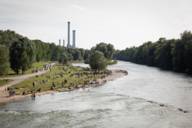
Wild, tamed, and now wild again: Munich's Isar has already undergone a number of transformations – a wild river in the 18th century, later a corseted canal, and nowadays the favorite swimming spot for the people of Munich. Thanks to the Isar Plan renaturation project you can once again swim in the river – and enjoy an area of Munich where people and animals can rest and relax. Here, we present the most important stops along our renaturation tour.
Many companies are currently trying to become more sustainable in an increasing number of work areas. But switching to more climate-neutral production, for example, is often far from easy. In such cases, it’s helpful to learn about a project that has very successfully transitioned to greater environmental friendliness. The Isar renaturation project is a prime example – and that is one of the reasons why the Munich Water Management Office offers tours along the river. "Environmental awareness and the positive treatment of our bodies of water is a major concern for us,” says Stefan Homilius, who heads the Munich Water Management Office. “That's why we offer on-demand tours, preferably for institutions that are concerned with the environment, water and environmental education."
Adventurous sustainability fans can also explore the renaturalized river on their own. On a half-day excursion, you can walk the "Nature" theme trail outside the city limits – less than 10 km between the Dürnsteiner Bridge near Schäftlarn and the Ickinger Weir with eleven information panels en route. A shorter four-stop walk in the city starts at the Wittelsbacher Bridge and ends at Isarwerk 2 near the Flaucher. It’s a good 2½ km long and can be comfortably managed in an hour. The most important stops along the tour are described below. Have fun exploring!
We start at Wittelsbach Bridge. When a flood inundated Munich in 1899, the previous iron bridge was one of the few bridges that withstood the water masses. But in the late 1950s after more devastating floods, the city decided to straighten the Isar even further. "Sections of the Isar in the city were heavily channelized until we started implementing the Isar Plan," Stefan Homilius explains. The Isar’s "corset" had many negative consequences, as the straightening measures undertaken in the 1960s and 1970s almost completely destroyed river-side human and animal habitats.
This was where the Isar Plan came into play. "The goals of the Isar Plan can be summed up in three points: keeping Munich residents safe from flooding, improving the ecology, and the recreational function," Stefan Homilius says. The Isar was extensively restored between 2000 and 2011. North of the Wittelsbach Bridge, for example, you can now see the willow island created during the renaturation as a retreat for flora and fauna. Now, animals and people are enjoying the Isar again, with the steps built around the Wittelsbach Bridge as part of the renaturation project well frequented in summer. Many Munich residents meet here to enjoy the joys of nature in the middle of the city.
Now the tour continues in a southerly direction along the Isar.
Welcome to our second stop, Braunau Railroad Bridge. Bridges are sensitive places during a flood because of the danger of entanglement: any wood carried along by a flooded river can become wedged up against the bridge piers. So, the embankment was reinforced with limestone during renaturation work on this bridge section. The idea was to prevent the Isar from flowing eastward and thus steer the section of the river with the strongest current away from the piers of Braunau Railroad Bridge.
On the way to our next stop, you can’t help noticing the occasional tree trunk people in Munich like to rest on. Remnants of a flood? No, the trunks were deliberately placed there to prevent trails from forming. During a flood, trails can cause deep erosion and deepen the riverbed. If you like, you can simply stop off here.
We carry on to the Flaucher, the place for swimming, barbecuing and relaxing during a Munich summer. Why not plan a small picnic stop here for your colleagues? The clear water here is not a matter of course. "In the upper section of the Isar, we installed sewage treatment plants equipped with disinfection systems to prevent pathogens from entering the water. This ensures the river has the right bathing quality," Stefan Homilius explains.
Before renaturation, it was inconceivable that fish could reproduce around the Flaucher. That was why the Isar Plan provided special resting zones for fish. "But it’s not only the fish that show you the ecological improvement," he explains. "You can see it in beetles and small insects as well. There are now species of butterflies here like the Adonis Blue or the Checkered Skipper Butterfly."
And now we’ve reached last stop, the Isarwerk. At the beginning of the 20th century, several hydroelectric power plants were built along the Isar together with the Isar-Werkkanal, where electricity is generated in a side arm of the Isar. Here, thought always has to be given to nature conservation, i.e. the water level of the Isar, and environmentally friendly energy generation, i.e. the Werkkanal.
And so we’ve got to the end of our tour. "Just put your feet in the Isar and experience it for yourself,” Stefan Homilius recommends. “In my opinion, that's an even better way of understanding renaturation than having it explained to you."
About a quarter of a century after the renaturation project started, the River Isar and its floodplains are among the city's most important characteristics. At the same time, they are an encouraging sign that large-scale sustainability projects can succeed – even if they take a little time. And that’s good to know for any company that has set itself ambitious sustainability goals.